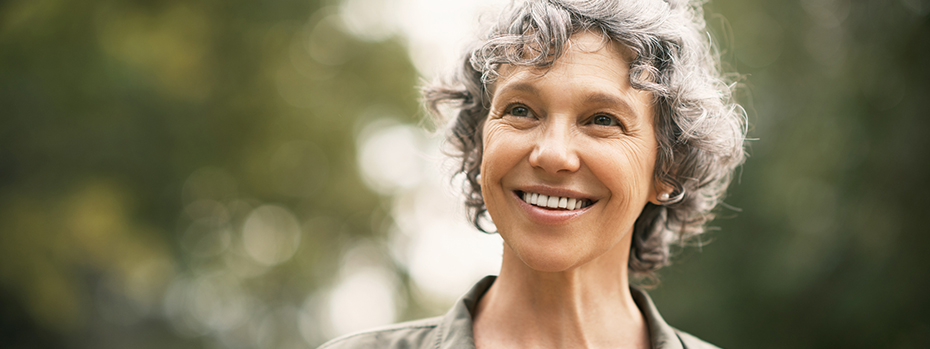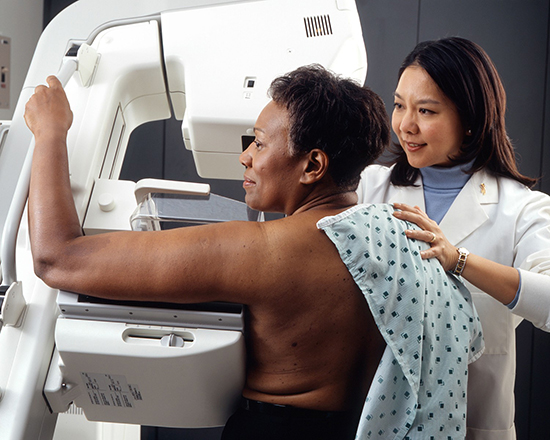Mammograms

Mammograms save lives: FAQ and what to expect
Breast cancer occurs in 1 out of 8 women and is the second leading cause of cancer death in women in the United States.
A mammogram is the best test we have to find breast cancer early. This is vital because the earlier you start treatment, the better your outcome.
The five-year relative survival rate for breast cancer is 99% if it’s caught early. The rate drops to 30% if it’s caught late.
What is a mammogram?
A mammogram is a low-dose X-ray of your breasts. The X-ray takes pictures of your breast tissue. The images can show if there is cancer or other changes in your breasts.
A mammogram cannot prove that an abnormal area is cancer. But if it raises suspicion, you can get other tests to tell for sure.
When should I start getting mammograms?
The age you start depends on your general health, your risk for breast cancer and other factors.
Most women in the United States start between ages 40 and 50. You may start earlier if you are at higher risk. (See "How do I know if I’m high risk?")
Most women get a screening mammogram every year or two. The decision about when to start and how often to screen for breast cancer is personal. It is based on your background, family history and more.
Several national health organizations issue guidelines on when to start getting mammograms:
- Breast Cancer: Screening, U.S. Preventive Services Task Force
- Mammography Saves Lives, American College of Radiology
- Breast Cancer Screening and Diagnosis, National Comprehensive Cancer Network
These guidelines evolve over time as technology gets better and new evidence emerges. Ask your provider what’s right for you.
How do mammograms work?
We do 3D mammograms, also called breast tomosynthesis. This technology is more accurate and helps find breast cancer earlier.
Our machine takes a series of low-dose X-rays from different angles. These images are compiled to create a complete picture of your breast.
Our experts look at the images to pinpoint anything that doesn’t look right. If the images reveal a spot or other potential sign of cancer, we will schedule you for another test.

What to expect
A technologist will ask you to undress above the waist and put on a hospital gown. The gown opens in front, so your body is covered except for the breast being X-rayed. The scan is done in a private room.
The machine is a large piece of equipment with a camera mounted on an arm that curves over your head.
You stand in front of the machine. The technologist will gently put your breast on a small platform. A flat plate will press down on your breast. This is called compression.
You may feel some discomfort during compression. Making your breast flat for a few seconds helps the machine get a good picture. The technologist will make you as comfortable as possible and finish as fast as possible.
The machine takes pictures of both breasts, one at a time. The whole process usually takes about 20 minutes.
What if I’m pregnant?
Let us know if you’re pregnant or think you might be pregnant.
Mammograms are generally considered safe if you’re pregnant. Mammograms expose you to a very low dose of radiation, which is aimed at your breasts, not your belly.
But scientists still aren’t sure about the effects of radiation on the developing fetus, even in very low doses. If you’re pregnant, you might consider a different test, such as ultrasound.
Before your mammogram
- Breasts are often tender the week before and during menstruation. Consider scheduling your mammogram for one to two weeks after your period starts.
- If your breasts are tender, try cutting back on caffeine for five to seven days before testing.
- Avoid using deodorant, perfume, powders or ointment on breasts or underarms on the day of your appointment. They can interfere with your scan.
At your mammogram
Let us know if:
- You are pregnant or think that you might be pregnant.
- You are breastfeeding.
- You have breast implants.
- You are taking any drugs or herbal supplements.
- Your last mammogram was done somewhere else. We will contact them to get previous images for comparison.
- You have any other concerns or questions.
After your mammogram
We’ll contact you to share the results. If your mammogram shows anything suspicious, we’ll schedule another test. If testing confirms a breast cancer diagnosis, we’ll connect you with our breast cancer team for expert treatment.
More frequently asked questions
Most of the time, breast lumps are not cancer, but cancer should be ruled out.
Most lumps are caused by cysts or fibroadenomas. A cyst is a cavity or pocket filled with fluid. A fibroadenoma is a mass of connective tissue that has clumped together.
These conditions are usually benign (not cancer) and often go away on their own. In some cases, they require treatment such as surgery or aspiration. In aspiration, your provider uses sound waves to guide a fine needle into the cyst and drain the fluid.
Always get a lump checked. If you notice something, we recommend that you talk with your primary care provider.
Breast pain, also known as mastalgia, is common. Most causes of breast pain are benign (not cancer) and not dangerous to your health.
Most women have breast pain or tenderness sometime in their lives. Pain can be caused by normal hormonal changes. It is sometimes related to your menstrual cycle.
We recommend that you talk with your primary care provider if:
- You have tried ways to reduce your pain and it doesn’t improve.
- Your symptoms worsen or affect your quality of life.
- The pain is focal (you can pinpoint the area of pain) and is not related to your period.
- You want to change your method of birth control.
- You want to take over-the-counter anti-inflammatory medication.
Nipple discharge is usually benign (not cancer).
Talk with your provider if:
- The discharge is from one breast only.
- The discharge is bloody or clear.
- The discharge appears on clothing.
Your breast has three kinds of tissue:
- Glandular tissue makes milk and conveys it to the nipple.
- Fibrous tissue maintains the structure and holds it all together.
- Fatty tissue fills the gaps and gives the breast its size and shape.
Women with dense breasts have more glandular and fibrous tissue. Dense breasts are significant for two reasons:
- Glandular and fibrous tissue look white on a mammogram, which can make it harder to see a small tumor.
- Women with dense breasts have a higher risk of getting breast cancer.
Ask your provider what this means for you.
Most skin changes are not caused by cancer, but cancer should be ruled out. Talk with your provider if you notice:
- Puckering or dimpling.
- Flaking, scaly or itchy skin.
- Thickened skin with enlarged pores.
- Your breast is warm to the touch, with redness or pain.
Inverted nipples point inward or lie flat instead of pointing out. Roughly 10% to 20% of women are born with inverted nipples. They are generally no cause for concern.
Talk with your provider if your nipple suddenly becomes inverted, however. It may be a sign of a medical problem.
Until 2015, women were encouraged to regularly examine their breasts. But medical evidence failed to show that self-exams did much to catch cancer early.
So while there is no harm in a self-exam, current guidelines focus on getting regular mammograms instead. The guidelines do advocate knowing how your breasts normally feel and look so you spot any changes.
Schedule a mammogram
Call 503-494-4673
Locations
OHSU Breast Center, South Waterfront
Center for Health & Healing, Building 2, ninth floor
3485 S. Bond Ave.
Portland, OR 97239
OHSU Mammography Clinic, Marquam Hill
Kohler Pavilion
808 S.W. Campus Drive
Portland, OR 97239
OHSU Mammography Clinic, Scappoose
51377 S.W. Old Portland Road
Scappoose, OR 97056
Free parking for patients and visitors
Refer a patient
- Refer your patient to OHSU.
- Call 503-494-4567 to seek provider-to-provider advice.
15 minutes that may have saved her life

Leola Kalamau took 15 minutes out of her hectic day to get screened at our roving Mammogram Van. She did it for her kids.